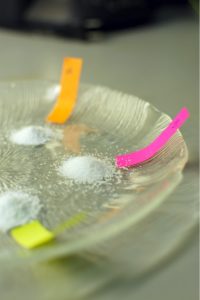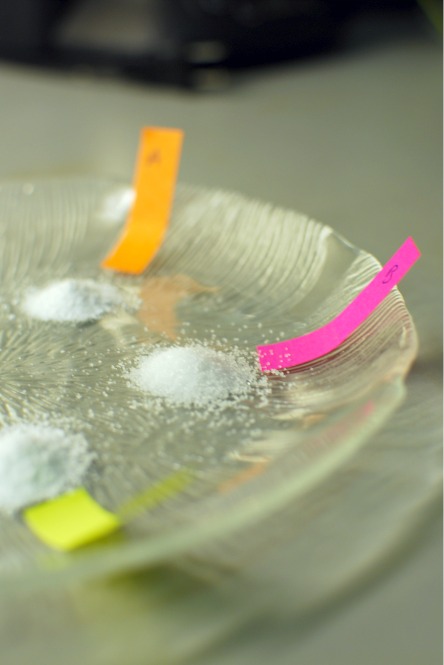 Splenda (aka sucralose) – 600x sweeter than sugar. This sweetener is heat stable, but is cloudy
Splenda (aka sucralose) – 600x sweeter than sugar. This sweetener is heat stable, but is cloudy
when dissolved. It does not attract moisture and doesn’t brown.- Sweet N’ Low (aka saccharin (US)/cyclamate (Canada)) – 300x sweeter than sugar. It has an unpleasant/bitter aftertaste. Saccharin was only recently approved for use in Canada but has been used in the US for quite some time.
- Equal, Nutrasweet (aka Aspartame) – 200x sweeter than sugar. Made up of two amino acids – asparatic acid and phenylalanine. It is not appropriate for people with the metabolic disorder phenylketonuria (PKU) who cannot metabolize phenylalanine. It is not heat stable and loses it’s sweetness with high cooking temperatures.
- Sugar Twin (aka cyclamate) – 30 – 50x sweeter than sugar. Some reports indicate that it has an unpleasant aftertaste but not as bad as saccharin.
My theory:
I think that it will be pretty obvious to tell which sample is real sugar. However, I think that the reviewers will have a hard time distinguishing the taste differences between sweeteners. I don’t even know if people will be able to identify which two are cyclamate (Sweet N Low and Sugar Twin).
Taste testers:
Please try all five of the samples. Please note the flavour, is there are any difference in the level of sweetness, and do you notice an after taste? Please indicate which sample you think is sugar, and which sweetener you like the most. For extra points: Can you tell which of the two samples are cyclamate?
The reveal:
Thank you taste testers for submitting your comments. Here are the results:
A: Sweet N Low (cyclamate)
B: Splenda (sucralose)
C: Sugar Twin (cyclamate)
D: Sugar (obviously)
E: Equal (aspartame)
The results:
These results were inconclusive. People could obviously tell which one was sugar because it was granular whereas all the other samples were a powder. People preferred sugar but mostly because it’s what they are familiar with. Sample C (Sugar Twin/cyclamate) had an awful metallic and slightly sour aftertaste. Sample A (Sweet N Low) which was also cyclamate had a salty after taste. Sucralose (Splenda) and aspartame (Equal) both tasted acceptable. All of the samples tasted much sweeter than sugar. It will be interesting to see how these measure up in the second part of this experiment – in baking.
The bottom line:
People could definitely taste an unpleasant aftertaste in the cyclamate samples (Sweet N Low and Sugar Twin). Both sucralose (Splenda) and aspartame (Equal) didn’t have a noticeable or unpleasant aftertaste. I will be using these two sweeteners for part 2 of this experiment when I use them in baking.

Here’s what I think…
A – minimal after taste
B – the sweetest
C – most artificial tasting and super sweet – cyclamate?
D – Sugar
E – reminds me of A
I think I like A the most. But actually, I’d choose brown sugar if at all possible.
LB
I’m not too familiar with sweeteners but here are my guesses:
Sugar: D
Nasty: C
Gross after taste: A
Splenda: B
Cyclamate: A & C (because they are both the same level of grossness)
Equal: E
Favourite (apart from sugar): B
After taste in: C, A
Very interesting Lisa! I’m curious what the outcomes would be in baked goods.
Looking forward to the answers!
Wow … lovely presentation! You can definitely see which one is real sugar. It is more grainy and smaller in size. The sweeteners are really really white and kind of powdery. So here’s what I think:
a.Equal
b.Splenda
c.Sweet N’ Low (has a weird aftertaste)
d.Real Sugar
e.Aspartame
That taste test is certainly the most difficult one as they all taste the same to me (referring sweeteners).
Thx Lisa! Really really fun!
It’s pretty easy to tell that D is sugar just by looking at it. Everything is powdery and sugar is gritty. C has the worst after-taste out of all the sweetners and A doesn’t seem to be as sweet.
d=sugar
I like sugar the best, but of the sweeteners I like e the best because it has the least after taste.
A=cyclamate, A is very bitter
D=sugar
A,B,C= Yuk B&C worst tasting strong chemical taste
Wild Guess
A and B = sugar twin and sweet and low
C = aspartame
E=splenda.
They all tastes equally sweet to me. I can tell which one is sugar because it’s granular whereas the others are in powder form.
A has a slightly salty after taste.
C has a nasty metallic after taste.
D is obviously sugar because it’s granular and the others are powders. I find both B and E as acceptable sugar substitutes. Let’s see how they hold up in baking.